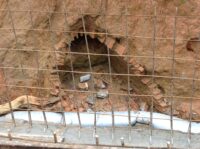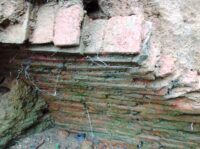A 1,400-year-old brick-lined tomb has been unearthed during construction of a drainage ditch in the commune of Xuan Hong, in central Vietnam’s Ha Yinh province. Workers discovered the arch structure of the tomb six feet under the surface in Village 2 of the rural commune and alerted the local heritage authorities.
The brickwork identifies it as a Han style tomb created during the rule of the Chinese Sui-Tang Dynasty (602-905). It is 13 feet long, three feet wide and four feet high, but the tomb was damaged during construction so what remains is only a part of it. The roof comes to a pointed arch formed by layers of bricks.
Some locals in the commune said they had found similar tombs in their gardens or during the process of building houses.
Many others said the same type of Han graves had been found in other localities in Ha Tinh.
The discovery of the ancient tomb in Xuan Hong Commune has created favourable conditions for archaeologists to study more about the Han tombs in Ha Tinh.


Such an excellent design, surviving all those centuries.
My question is whether they informed the authorities when they first found the structure or after they had removed enough for their construction work… 😉
At least the bricks look younger than ever, and isn’t there always a mausoleum to be built? 😎
Ages ago, I visited the beehive tomb otherwise referred to as the “Treasury of Atreus” or “Tomb of Agamemnon”, a tholos at Mycenae in Greece, constructed during the Bronze Age around 1250 BC. The stone lintel above the doorway alone weighs 120 tons in 8.3 * 5.2 * 1.2m^3 or 1829 ft^3. Nearby, there is the “Tomb of Clytemnestra”, and indeed, one might wonder, what all that free space was used for.
Those bricks used in central Vietnam’s Ha Yinh province are seemingly not totally different to the ones that Augustus was using for his mausoleum, but they do in fact differ a lot from what had been used in the Bronze Age.
it is the renowned tomb of the creator of pho soup. :hattip: